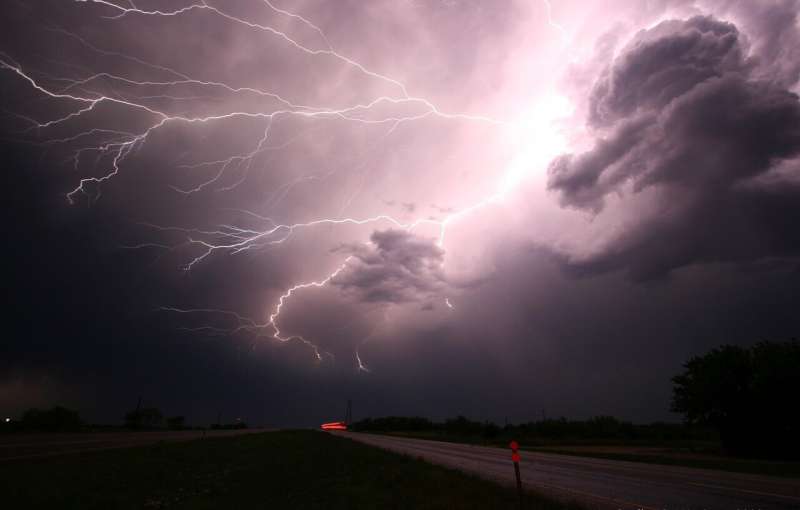This article has been reviewed according to Science X's editorial process and policies. Editors have highlighted the following attributes while ensuring the content's credibility:
fact-checked
reputable news agency
proofread
Are California's storms normal, or is climate change making them worse? What experts say

California faces a "parade of storms" over the next several weeks, on top of recent deluges that have killed at least 12 people, caused flooding, knocked out power and forced evacuations and school closures up and down the coast.
Given the Mediterranean climate of the state's coastal areas, wet winters and dry summers are a natural part of California's weather patterns going back millennia.
But are this year's storms something out of the ordinary, and something that can be attributed to climate change? In a state home to almost 40 million people with a $3.6 trillion economy—on track to be the fourth biggest in the world—the weather matters.
Here's what to know.
What's happening in California with the storms?
President Joe Biden declared a federal emergency Sunday to aid California, which is in the thick of what National Weather Service meteorologists have called a
"conveyer belt" of storms. The first one hit New Year's Eve, the next began Friday and lasted through the weekend, and another lashed coastal areas Sunday night through Monday. Several more are on the way.
A dried pattern doesn't seem likely until Jan. 20 at least, said Daniel Swain, a climate scientist at the University of California, Los Angeles in a news conference Monday.
Are California's storms normal?
California's coastal climate is naturally marked by wet winters and dry summers but that pattern contains a large amount of variability. The historical record as well as paleoclimatological studies looking over millennia show periods of severe drought and periods of extreme wetness.
The drought of the past several years has been extreme. Last January, February and March were the driest three months in recorded state history in terms of rainfall and snowfall.
Because much of the state has been in drought conditions for so long, many residents either have forgotten, or never experienced, just how wet things can get. The last truly wet period was in the 1990s.
But in reality, California's climate is intrinsically variable.
"We have in recent years become accustomed to quite dry conditions and a lot of winters that didn't feel much like winter in a lot of California past decade or so," Swain said. "And that is both unusual, but also typical in the longer context."
What does climate change have to do with the California storms?
It's too soon to say if this spate of winter storms is part of a larger climate change-driven shift or were just the luck of the draw. However, climate scientists are clear that overall, the state's weather is becoming more variable and more intense, which is very much a long-predicted effect of global warming.
The natural variability of the state's climate has masked the increases, said Swain.
Climate scientists in California are calling this "precipitation whiplash," where when it rains, the rains are heavier and more catastrophic at the same time that droughts can become longer and more intense.
That's because the overall heating of the atmosphere creates greater variability. Since the Industrial Revolution in the 1800s, the world's temperature has already increased by about 1.7 degrees Fahrenheit, with more increases coming.
"Climate change today has probably already doubled the risk of an extremely severe storm sequence in California," Swain said. "That risk has increased quietly in the background during a period of extreme drought."
California is also getting drier
Climate change is adding to the risk of extreme heat events, scientists at the National Oceanic and Atmospheric Administration said at a briefing Monday.
One study they cited looked at climate extremes in California and Nevada between October 2020 and September 2021 and concluded human-caused climate change and La Niña together led to a more than six-fold increase in the risk of compound hot and dry extremes.
One of the major climate change-driven impacts emerging from the studies is the intensity of heat waves, said NOAA climate scientist Stephanie Herring.
"Research is showing that these extreme heat events are also likely to become the new normal in the not too distant future," she said.
How can climate change make California both drier and wetter?
The underlying concept is simple. When more energy is added to the Earth's atmospheric system, it becomes more volatile, said Katharine Hayhoe, an atmospheric scientist and professor at Texas Tech University.
"Climate change is loading the weather dice against us. We always have a chance of rolling a double six, a hurricane or a heat wave," she said. "As the Earth warms, the chances of getting a six or a seven increases."
(c)2023 USA Today
Distributed by Tribune Content Agency, LLC.



















